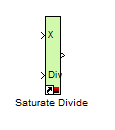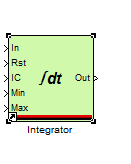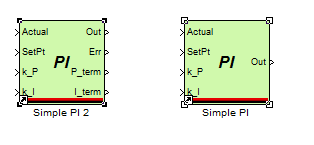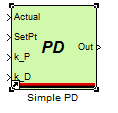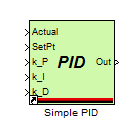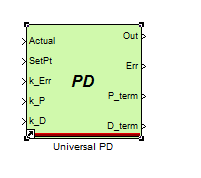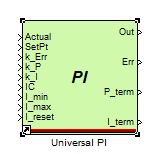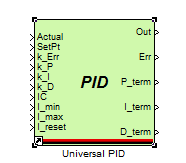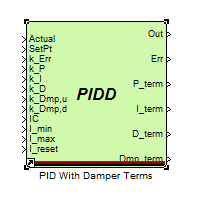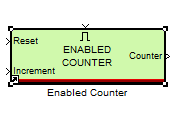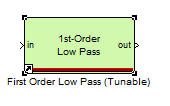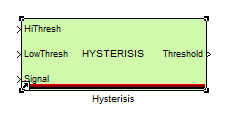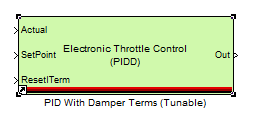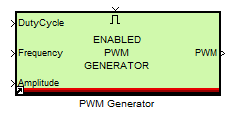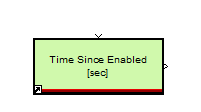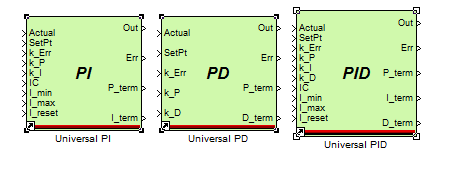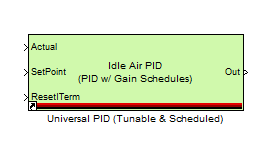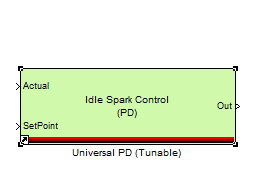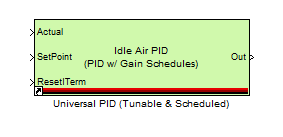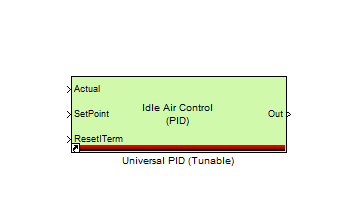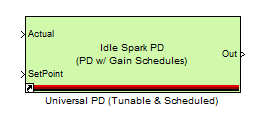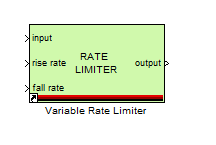Foundation Block Set: Difference between revisions
No edit summary |
No edit summary |
||
| Line 1: | Line 1: | ||
==Foundation Control Block Set== | ==Foundation Control Block Set== | ||
| Line 73: | Line 72: | ||
The Universal PI, PD, PID blocks allow a user to quickly implement many types of control loops. | The Universal PI, PD, PID blocks allow a user to quickly implement many types of control loops. | ||
===PID With Damper Terms:=== | |||
[[image:PID_with_damper_terms.PNG| PID with damper terms]] | |||
This block helps the user implement a PID with Damper Terms. | |||
[[image:Counter_blocks.PNG| Counter blocks]] | [[image:Counter_blocks.PNG| Counter blocks]] | ||
| Line 89: | Line 94: | ||
[[image:PID_with_damper_terms_(tunable).PNG| PID with damper terms (tunable)]] | [[image:PID_with_damper_terms_(tunable).PNG| PID with damper terms (tunable)]] | ||
[[image:Polynomial_Tunable.PNG| Polynomial Tunable]] | [[image:Polynomial_Tunable.PNG| Polynomial Tunable]] | ||
| Line 113: | Line 116: | ||
[[image:Universal_PD_Tunable.PNG| Universal PD Tunable]] | [[image:Universal_PD_Tunable.PNG| Universal PD Tunable]] | ||
[[image:Universal_PID_(tunable_&_Scheduled).PNG| Universal PID (tunable and scheduled)]] | [[image:Universal_PID_(tunable_&_Scheduled).PNG| Universal PID (tunable and scheduled)]] | ||
[[image:Universal_PID_(Tunable).PNG| Universal PID (tunable)]] | [[image:Universal_PID_(Tunable).PNG| Universal PID (tunable)]] | ||
[[image:Universal_PD_tunable_and_Scheduled.PNG| Universal PD (tunable and scheduled)]] | [[image:Universal_PD_tunable_and_Scheduled.PNG| Universal PD (tunable and scheduled)]] | ||
[[image:Variable_Rate_Limiter.PNG| Variable Rate Limiter.]] | [[image:Variable_Rate_Limiter.PNG| Variable Rate Limiter.]] | ||
Revision as of 19:21, 20 June 2012
Foundation Control Block Set
First Time Block:
The first time block sends a true signal out the first time the subsystem it is in is triggered. All other executions of that subsystem will have this block output a false signal.
Compare To:
The Compare To block allows the user to compare an inputted value vs. the given value in the mask. It will output a true signal when the values match.
Falling Edge:
This block detects a falling edge and outputs a value when it does so.
Derivative:
This block takes the derivate of an inputted signal.
Saturation:
The saturation block takes a min, max and inputted value. It then outputs the inputted signal when it is between the min max. When the inputted signal goes over the boundaries it outputs the min or max values.
First Order Low Pass:
The 'alpha' input is T/t. So when alpha = 1, the block simply passes the input through to the output, and when alpha = 0, the block forever holds its last output value.
Median Filter:
This filter block stores the number of data points that the user requests and gives the median of those values.
Time Since Enabled:
The Time Since Enabled block outputs the amount of time that has elapsed since the enable input has gone high. It holds its value when the enable input goes low, but resets again when it goes high.
Saturate Divide:
When the divisor is less than the numerator or zero, saturate and output one.
Integrator
The integrator block takes an incoming signal and integrates it. You can set a Min and Max value for the output. You can also enable the signal with the Rst signal, and it will output the IC value.
Simple PI, PD, and PID Blocks:
The simple PI, PD, and PID block set allows a user to quickly implement basic control loops.
The Universal PI, PD, and PID Blocks
The Universal PI, PD, PID blocks allow a user to quickly implement many types of control loops.
PID With Damper Terms:
This block helps the user implement a PID with Damper Terms.







